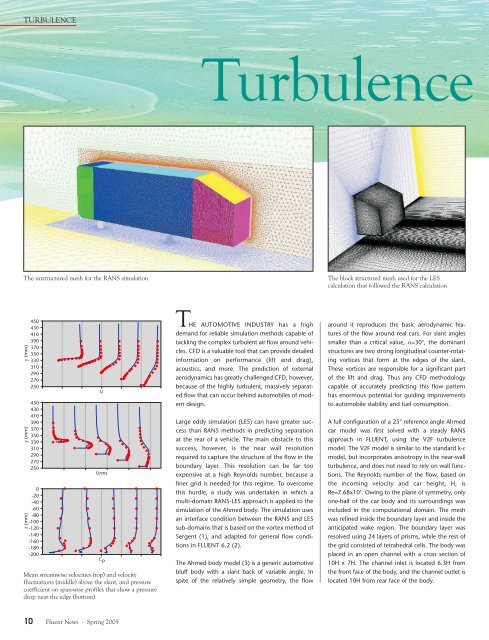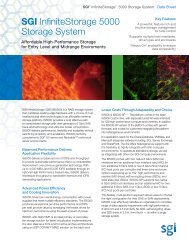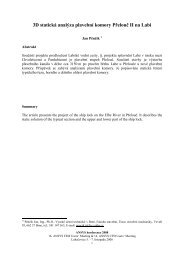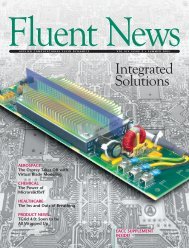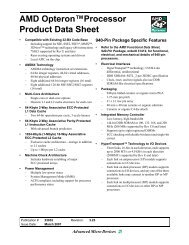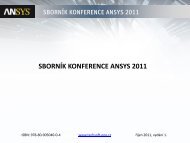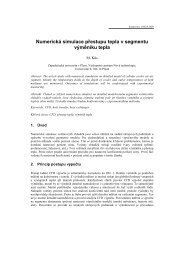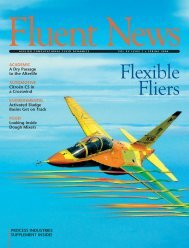Print Fluent Newsletter
Print Fluent Newsletter
Print Fluent Newsletter
Create successful ePaper yourself
Turn your PDF publications into a flip-book with our unique Google optimized e-Paper software.
TURBULENCETurbulenceThe unstructured mesh for the RANS simulationThe block structured mesh used for the LEScalculation that followed the RANS calculationy (mm)y (mm)z (mm)4504304103903703503303102902702504504304103903703503303102902702500-20-40-60-80-100-120-140-160-180-200UUrmsMean streamwise velocities (top) and velocityfluctuations (middle) above the slant, and pressurecoefficient on span-wise profiles that show a pressuredrop near the edge (bottom)CpTHE AUTOMOTIVE INDUSTRY has a highdemand for reliable simulation methods capable oftackling the complex turbulent air flow around vehicles.CFD is a valuable tool that can provide detailedinformation on performance (lift and drag),acoustics, and more. The prediction of externalaerodynamics has greatly challenged CFD, however,because of the highly turbulent, massively separatedflow that can occur behind automobiles of moderndesign.Large eddy simulation (LES) can have greater successthan RANS methods in predicting separationat the rear of a vehicle. The main obstacle to thissuccess, however, is the near wall resolutionrequired to capture the structure of the flow in theboundary layer. This resolution can be far tooexpensive at a high Reynolds number, because afiner grid is needed for this regime. To overcomethis hurdle, a study was undertaken in which amulti-domain RANS-LES approach is applied to thesimulation of the Ahmed body. The simulation usesan interface condition between the RANS and LESsub-domains that is based on the vortex method ofSergent (1), and adapted for general flow conditionsin FLUENT 6.2 (2).The Ahmed body model (3) is a generic automotivebluff body with a slant back of variable angle. Inspite of the relatively simple geometry, the flowaround it reproduces the basic aerodynamic featuresof the flow around real cars. For slant anglessmaller than a critical value, α=30°, the dominantstructures are two strong longitudinal counter-rotatingvortices that form at the edges of the slant.These vortices are responsible for a significant partof the lift and drag. Thus any CFD methodologycapable of accurately predicting this flow patternhas enormous potential for guiding improvementsto automobile stability and fuel consumption.A full configuration of a 25° reference angle Ahmedcar model was first solved with a steady RANSapproach in FLUENT, using the V2F turbulencemodel. The V2F model is similar to the standard k-εmodel, but incorporates anisotropy in the near-wallturbulence, and does not need to rely on wall functions.The Reynolds number of the flow, based onthe incoming velocity and car height, H, isRe=7.68x10 5 . Owing to the plane of symmetry, onlyone-half of the car body and its surroundings wasincluded in the computational domain. The meshwas refined inside the boundary layer and inside theanticipated wake region. The boundary layer wasresolved using 24 layers of prisms, while the rest ofthe grid consisted of tetrahedral cells. The body wasplaced in an open channel with a cross section of10H x 7H. The channel inlet is located 6.3H fromthe front face of the body, and the channel outlet islocated 10H from rear face of the body.10 <strong>Fluent</strong> News · Spring 2005


